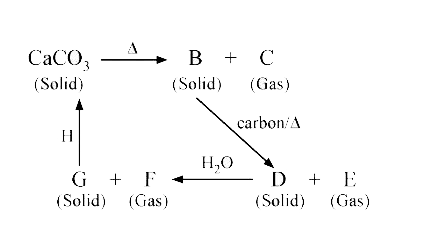Mark the correct statements about halogens.
Electron affinity of halogens is in the order F>Cl>Br>I.
HF is the strongest hydrohalic acid.
F2 has lower bond dissociation energy than Cl2
All halogens show variable oxidation states.
The correct Answer is:C
To determine the correct statements about halogens, let's analyze each option one by one.
Step 1: Analyze Option 1
- The statement claims that the electron affinity of halogens is in the order: F > Cl > Br > I.
- However, the correct order of electron affinity is actually Cl > F > Br > I. Chlorine has the highest electron affinity due to its larger atomic size compared to fluorine, which makes it easier for chlorine to accept an electron.
- Conclusion: Option 1 is incorrect.
Step 2: Analyze Option 2
- The statement claims that HF is the strongest hydrohalic acid.
- HF is not the strongest hydrohalic acid; in fact, it is one of the weakest due to hydrogen bonding between HF molecules, which makes it difficult for HF to release H+ ions into solution.
- Conclusion: Option 2 is incorrect.
Step 3: Analyze Option 3
- The statement claims that F2 has lower bond dissociation energy than Cl2.
- This statement is correct. The bond in F2 is weaker due to inter-electronic repulsion between the lone pairs of the small fluorine atoms, which makes the bond easier to break compared to Cl2, where such repulsion is less significant.
- Conclusion: Option 3 is correct.
Step 4: Analyze Option 4
- The statement claims that all halogens show variable oxidation states.
- This is misleading. While halogens can exhibit different oxidation states, they predominantly exhibit a single oxidation state of -1 in most compounds.
- Conclusion: Option 4 is incorrect.
Final Conclusion: The only correct statement is Option 3: F2 has lower bond dissociation energy than Cl2.
- The statement claims that the electron affinity of halogens is in the order: F > Cl > Br > I.
- However, the correct order of electron affinity is actually Cl > F > Br > I. Chlorine has the highest electron affinity due to its larger atomic size compared to fluorine, which makes it easier for chlorine to accept an electron.
- Conclusion: Option 1 is incorrect.
- The statement claims that HF is the strongest hydrohalic acid.
- HF is not the strongest hydrohalic acid; in fact, it is one of the weakest due to hydrogen bonding between HF molecules, which makes it difficult for HF to release H+ ions into solution.
- Conclusion: Option 2 is incorrect.
- The statement claims that F2 has lower bond dissociation energy than Cl2.
- This statement is correct. The bond in F2 is weaker due to inter-electronic repulsion between the lone pairs of the small fluorine atoms, which makes the bond easier to break compared to Cl2, where such repulsion is less significant.
- Conclusion: Option 3 is correct.
- The statement claims that all halogens show variable oxidation states.
- This is misleading. While halogens can exhibit different oxidation states, they predominantly exhibit a single oxidation state of -1 in most compounds.
- Conclusion: Option 4 is incorrect.
Topper's Solved these Questions
- BOOK - NCERT FINGERTPS ENGLISHCHAPTER - THE P-BLOCK ELEMENTS EXERCISE - HOTS7videos
THE P-BLOCK ELEMENTS
- BOOK - NCERT FINGERTPS ENGLISHCHAPTER - THE P-BLOCK ELEMENTS EXERCISE - EXAMPLAR PROBLEMS25videos
THE P-BLOCK ELEMENTS
- BOOK - NCERT FINGERTPS ENGLISHCHAPTER - THE D- AND F- BLOCK ELEMENTS EXERCISE - Assertion And Reason15videos
THE D- AND F- BLOCK ELEMENTS
- BOOK - NCERT FINGERTPS ENGLISHCHAPTER - THE SOLID STATE EXERCISE - Assertion And Reason15videos
THE SOLID STATE
Similar Questions
Mark the correct statement/s-:
View SolutionMark the correct statement(s).
View SolutionMark the correct statement(s).
View SolutionMark the correct statement (s).
View SolutionMark the correct statements (s).
View SolutionThe correct statements about anomers are
View SolutionMark the correct statement about given graph:
 View Solution
View SolutionMark the correct statements about the friction between two bodies
View Solution
The correct statement about F isView SolutionMark the correct statement/s about arithmetic growth.
View Solution

